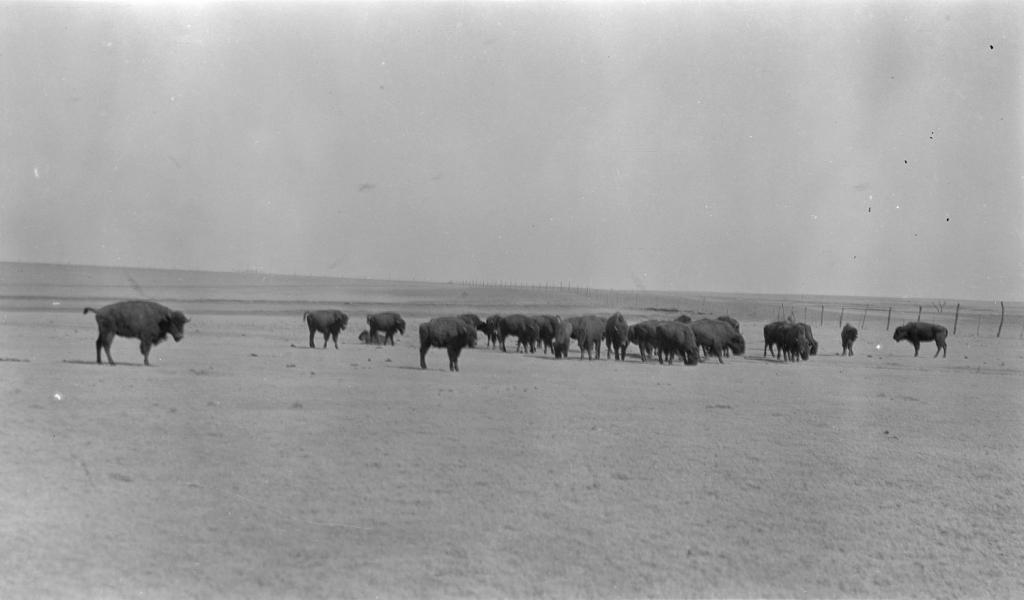
https://texashistory.unt.edu/ark:/67531/metapth44851/?q=charles%20goodnight
Charles Goodnight was born in Illinois in 1836, but moved near the Brazos River in Texas around the age of nine. Goodnight is referred to by some as the “Father of the Texas Panhandle” for his part in establishing the region. Goodnight, Texas was named after him, and this is where he and his first wife, Mary Ann Goodnight, were laid to rest.
He held several jobs in this younger years to support his widowed mother, but didn’t begin ranching until he was introduced to it by John Wesley Sheek, his step-brother, in 1856. In 1866, Charles Goodnight and Oliver Loving created the first trail that drove cattle to Western Markets, where the beef would make its way to Natives on reservations and soldiers. The Goodnight-Loving Trail (as its known today) went all the way from Fort Griffin to Fort Sumner in New Mexico. This trail became one of the most used, and helped expand the cattle industry.

https://texashistory.unt.edu/ark:/67531/metapth675231/?q=goodnight%2C%20texas
Ten years after the Goodnight-Loving Trail was established, Charles Goodnight stopped driving cattle on that road to establish the first great ranch in the Panhandle in Palo Duro Canyon. He was not the only person to scout out the area after the Natives had been evacuated, but held claim to the land by bringing 1,600 longhorns to the area. A year later, after finding an investor, Goodnight was able to purchase the canyon and the land around it. At its peak, around a decade after JA Ranch had been established, the ranch encompassed 1,325,000 acres, and at one point had 100,000 cattle. Not a full two years after the Comanche had lost their claim to the canyon, Palo Duro’s function in society had been radically transformed by Anglo-Americans and in true American form, capitalized upon.
The JA Ranch’s reign wasn’t long due to drought and the decline of the beef market, but Goodnight kept a some of the land and a small herd until the end of his life. Though he initially drove out most of the buffalo when establishing the ranch, eventually Goodnight tended to a herd of bison on land to prevent them from being over-hunted, and occasionally allowed Native Americans to come down from their reservations in Oklahoma to hunt them. As well, he experimented in the cross-breeding of his cattle and the buffalo to produce “Cattalo”. Goodnight’s bison, photographed in 1918:

https://texashistory.unt.edu/ark:/67531/metapth1150121/
A bit of a side note, because I find it a tad ironic: In 1857, Goodnight joined the Texas Rangers under Captain Jack Cureton as a scout and guide. In December of that year, he led the Rangers to the Comanche camp on Mule Creek where Cynthia Ann Parker, the white American mother of Chief Quanah Parker who had been present for the Battle of Palo Duro, was located. Though Cynthia had become apart of the Comanche tribe and had no desire to return to white America, the Rangers captured her in the raid. Cynthia was unable escape to be back with her tribe, and died a few years after. Eighteen years after her recapture, Charles Goodnight would sign a treaty with Quanah that offered to supply the Comanche people with cattle so long as they didn’t disturb the JA Ranch (which as previously noted, used to be their territory). The two maintained a professional friendship through the years.
Citations:
Allen, Anderson H. 2010. “GOODNIGHT, CHARLES | The Handbook of Texas Online| Texas State Historical Association (TSHA).” Tshaonline.Org. June 15, 2010. https://tshaonline.org/handbook/online/articles/fgo11.
“Charles Goodnight.” Nps.gov. National Park Service, February 24, 2015. https://www.nps.gov/cavo/learn/historyculture/charles-goodnight.htm.
Hagan, William T. Charles Goodnight : Father of the Texas Panhandle. Norman: University Of Oklahoma Press, 2007
Burton, Harley True. “A History of the J A Ranch, II.” The Southwestern Historical Quarterly 31, no. 3 (1928): 221-60. http://www.jstor.org.library.collin.edu/stable/30234997.
Campbell, Randolph B. Gone to Texas : A History of the Lone Star State. 3rd ed. New York: Oxford University Press, 2018.
Hacker, Margaret S. “PARKER, CYNTHIA ANN | The Handbook of Texas Online| Texas State Historical Association (TSHA).” Tshaonline.Org, 15 June 2010, tshaonline.org/handbook/online/articles/fpa18. Accessed 8 Nov. 2019.